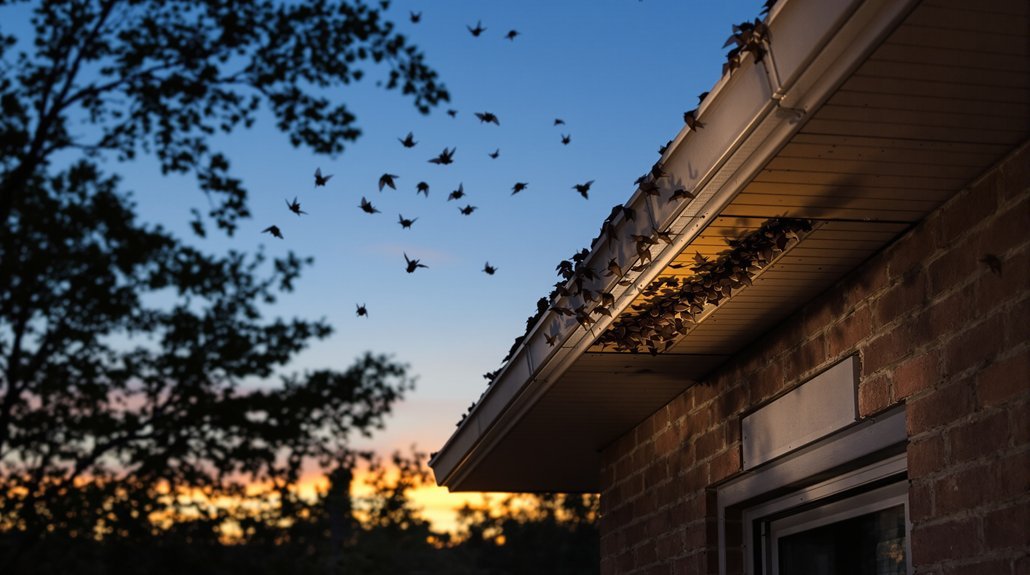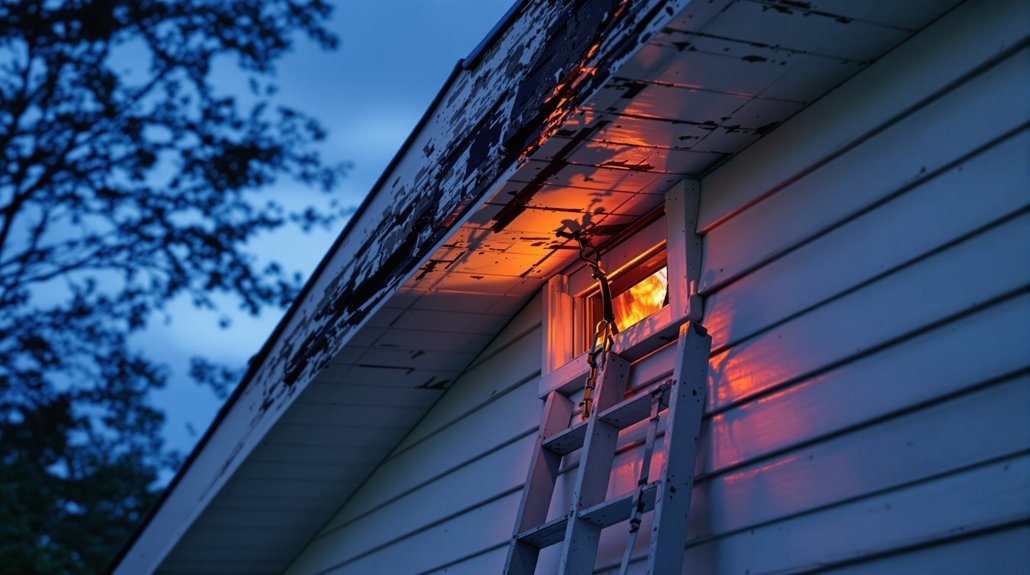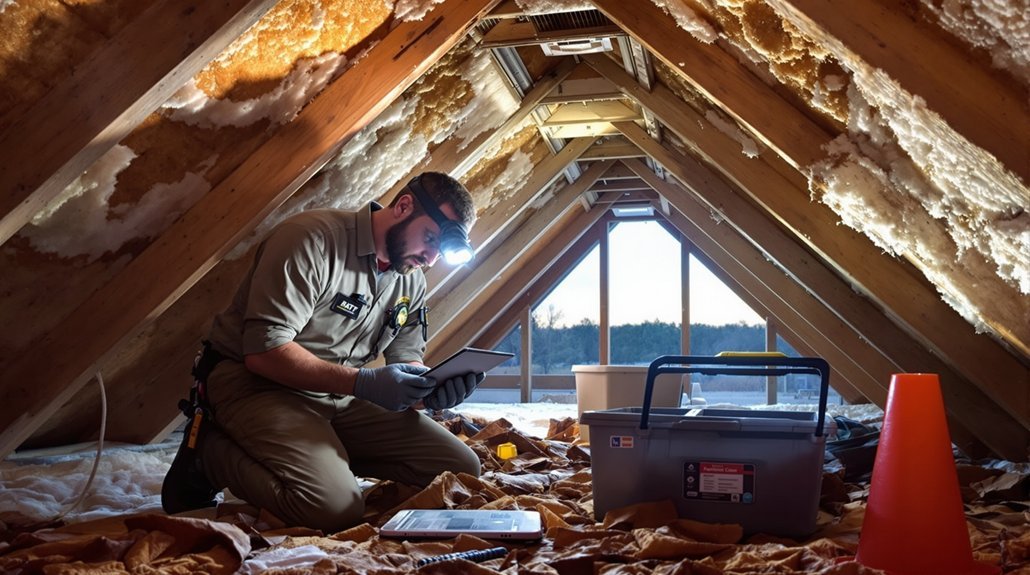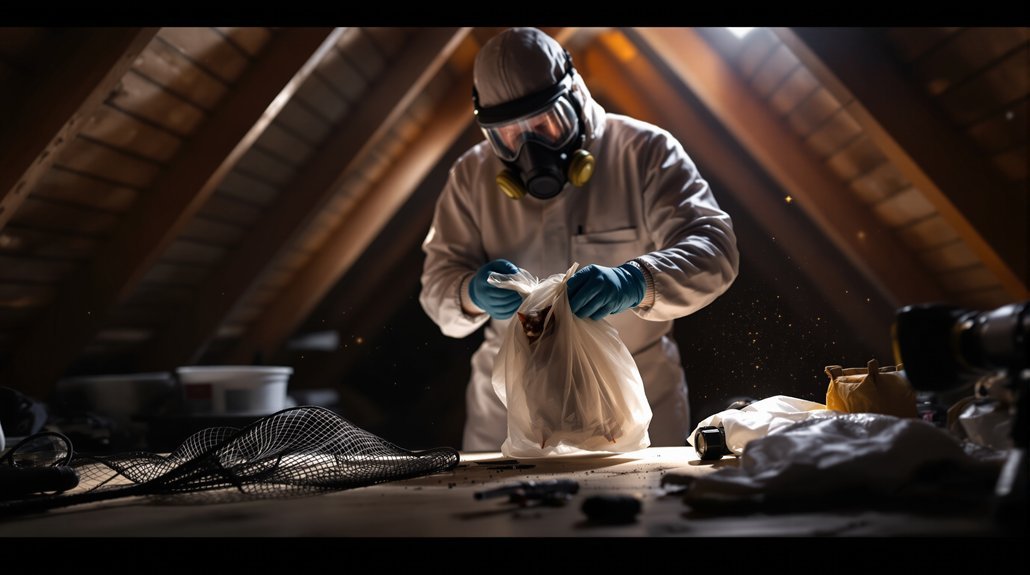The process for bat removal in Des Moines, Iowa begins with understanding bat behavior and identifying entry points. Professionals inspect the property for signs of bat activity and assess the infestation level. Legal considerations guarantee humane eviction techniques are used. Once bats are removed, sealing entry points and cleaning up is essential. Homeowners are advised on preventive measures. For a deeper understanding of each step involved, exploring further details can provide additional insights.
Key Article Highlights
- Identify entry points and signs of bat activity, such as droppings or noises, to assess the infestation level.
- Obtain necessary permits for bat removal, especially if dealing with protected species.
- Use humane exclusion methods, like one-way doors, to safely remove bats without harm.
- Seal all entry points after removal to prevent future infestations and conduct thorough cleanup.
- Regularly monitor the property during migration seasons to ensure no new bats return.
Understanding Bat Behavior and Habitat

Although bats are often misunderstood, they play a vital role in the ecosystem. Bats are known for their unique behaviors and habitats. They use echolocation for bat navigation, allowing them to find food and avoid obstacles in the dark. During warmer months, bats seek out summer roosts, which provide shelter and safety. These roosts can be found in various locations, such as caves, trees, and even buildings. Bats tend to return to the same roosts year after year, which makes them predictable in their habitat choices. Understanding their behavior and preferred environments is essential for effective bat removal strategies. Recognizing their specific habitat preferences can significantly improve the success of exclusion efforts. Additionally, bats often follow air currents between connected spaces, which can influence where they choose to roost.
Identifying Entry Points

Identifying entry points is essential for effective bat removal. Common locations include gaps in roofs, chimneys, and vents. Signs of infestation can help homeowners locate where bats are entering their homes.
Common Entry Locations
Bats often find their way into homes through specific entry points. Understanding these entry locations is essential for effective bat removal. Common entry points include:
- Gaps in Roofs: Cracks or holes can allow bats to enter, especially during migration.
- Attic Vents: Poorly sealed vents provide easy access for bats seeking shelter.
- Chimneys: Uncovered chimneys can serve as a direct entry point for bats.
- Soffits and Fascia: Loose or damaged areas in these structures can create openings.
Bats are attracted to homes primarily for roosting, as they may seek refuge while following their food sources. Understanding bat diet and migration patterns helps homeowners identify potential vulnerabilities in their structures.
Signs of Infestation
Homeowners should be vigilant for signs of bat infestation, especially after recognizing common entry locations. Noticing droppings is a clear indicator. Bat droppings, or guano, can often be found near entry points. Another sign is the sound of fluttering wings or scratching noises, particularly at dusk or dawn when bats are active. Additionally, homeowners should look for stains or marks on walls, which may indicate frequent access. Understanding bat diet is important, as these creatures are drawn to areas with abundant insects. During bat migration seasons, entry points may become more active. Identifying these signs early can help homeowners take action before a larger infestation develops, ensuring a safer living environment.
Assessing the Infestation

Evaluating the infestation involves two key steps. First, it is important to identify the bat species present, as different species may require different removal methods. Next, inspecting the entry points can help determine how the bats are getting inside and guide the removal process.
Identifying Bat Species
Often overlooked, identifying the species of bats present in an area is essential for effective removal strategies. Different species have unique behaviors, diets, and migration patterns, which can influence removal methods. Understanding these factors aids in developing a tailored approach.
- Bat Migration: Some species migrate seasonally, affecting their presence and removal timing.
- Bat Diet: Knowing what bats eat can help locate their roosting sites and feeding grounds.
- Physical Characteristics: Size, color, and wing shape can distinguish between species.
- Behavioral Traits: Flight patterns and social habits provide insight into the specific species present.
Inspecting Entry Points
When dealing with a potential bat infestation, inspecting entry points is essential for understanding the extent of the problem. Observers should note bat flight patterns and the locations where bats enter and exit. This information helps in determining their roost site selection.
| Entry Point Type | Common Features | Inspection Tips |
|---|---|---|
| Gaps in Roof | Cracks, holes | Look near eaves |
| Vents | Unscreened openings | Check for droppings |
| Chimneys | Unsealed tops | Listen for sounds |
Legal Considerations for Bat Removal
Understanding the legal considerations for bat removal in Des Moines, Iowa, is essential for homeowners and pest control professionals alike. Compliance with wildlife legislation is vital, as bats are often protected species. Failure to adhere to these laws can result in penalties.
Key considerations include:
- Permits: Homeowners may need permits to remove bats legally.
- Timing: Removal must occur outside of breeding seasons, which vary by species.
- Property Management: Landowners are responsible for maintaining structures to prevent bat entry.
- Humane Practices: Methods used must comply with ethical guidelines to ensure humane eviction.
Navigating these legal aspects helps avoid conflicts and promotes responsible wildlife management.
Safe and Humane Eviction Techniques
After addressing the legal considerations for bat removal, it is important to focus on safe and humane eviction techniques. These methods prioritize the well-being of the bats while ensuring they are removed from human spaces. One effective technique involves understanding bat echolocation to identify their entry points. Additionally, colony separation can be performed during the bats’ non-breeding season to minimize disturbance.
| Technique | Description |
|---|---|
| Exclusion | Sealing entry points after bats leave |
| One-way Doors | Allow bats to exit, but not re-enter |
| Monitoring | Observing behavior before removal |
| Timing | Evicting during non-breeding months |
| Professional Help | Consulting experts for humane methods |
Preventing Future Infestations
Preventing future infestations of bats requires a proactive approach to home maintenance and environmental management. Homeowners can implement several effective prevention strategies to minimize bat habitat around their properties.
Taking proactive measures in home maintenance can effectively prevent future bat infestations.
- Seal Entry Points: Inspect roofs, attics, and walls for gaps or cracks, and seal them to block access.
- Remove Food Sources: Keep outdoor areas clean and free of insects, which attract bats.
- Limit Shelter: Trim trees and remove debris to reduce potential roosting sites.
- Install Screens: Use mesh screens on vents and chimneys to prevent bats from entering.
Cleaning and Repairing Damage
Once bats have been successfully removed from a property, addressing any damage they may have caused becomes important. Bat colonies can create significant issues, including droppings that lead to health concerns. Cleaning up bat droppings is essential for maintaining bat health and preventing disease. It is vital to wear protective gear during this process to avoid inhaling harmful particles. Additionally, any areas where bats nested should be repaired. This includes sealing entry points and fixing insulation or drywall that may have been damaged. The colony size can influence the extent of the damage, so thorough assessments are necessary. Proper cleaning and repair not only restore the property but also help prevent future infestations.
When to Call a Professional Wildlife Removal Service
Recognizing the right time to call a professional wildlife removal service is crucial for effective bat removal. Homeowners should consider seeking help when they notice specific signs indicating a bat presence.
- Frequent sightings: If bats are often seen flying around the home, it may be time to act.
- Bats in living areas: Finding bats inside living spaces can pose health risks due to their diet, which includes insects.
- Noise and droppings: Hearing unusual noises or discovering bat droppings indicates a roosting area.
- Migration seasons: During bat migration periods, increased activity may require professional intervention to prevent infestation.
Timely action is essential to ensure safe and effective bat removal.

